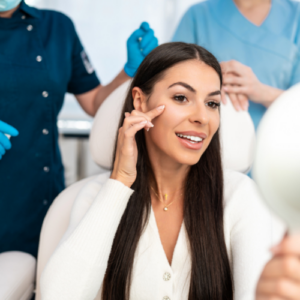
Freckles and Age Spots – How to Zap Them Away and Keep Them at Bay
Reviewed by Lauren Scott, DNP, FNP-BC
Freckles – those flecks of golden brown splashed across your face and chest – may have been with you since childhood. Maybe they were cute then but perhaps you’re over them? Or other telltale brown spots have emerged as years of sun exposure take their toll. Either way, no need to feel self-conscious and pile on concealer.
Whether summer sun has caused your freckles to proliferate or produced age spots, you can meet with a California Skin Institute dermatologist or advanced practitioner to strategize on how best to banish those brown dots. And learn how to keep them from returning.
Appearance aside, freckles, age spots and their 3-D cousins, moles, could signal skin cancer, a serious condition your dermatologist will explore with you. If your freckles and sunspots are determined to be benign, they can be removed by in-office treatments, including lasers, peels, prescription topical creams, or a combination, depending on the type and number of spots you have and your skin condition.
What Are Freckles and How Do They Get There?
The word freckle derives from the Middle English term freken, which itself comes from the Old Norse freknur. All three words mean the same thing: those brown spots.
Freckles usually occur in clusters across larger areas of the skin. Age spots tend to emerge by themselves or in proximity to one or two others. Both freckles and age spots are caused by skin pigmentation called melanin.
Melanin is the pigment that gives skin, hair, and eyes color. Melanin is formed by specialized cells called melanocytes. Their job is to try to protect us from the sun’s harmful rays. Sun exposure activates them. People with darker skin tones have evolved to have more melanocytes which can result in a more uniform appearance. Lighter-skinned people’s melanocytes respond to sun exposure with freckles. Some freckling however may be hereditary and appear regardless of sun exposure. Whereas years of sun exposure will cause age spots, small, concentrated areas of increased melanin production, for nearly all types of skin.
The darker coloration of freckles and age spots depends on how many melanocytes cluster together, and how much melanin those clusters produce.
Freckles come in one of two types:
Ephelides is a Greek-derived medical term for the kind of freckles that develop during summer from sun exposure. These freckles tend to be light brown and usually disappear in winter. Sun protection, including sunscreen, can help prevent them. Be aware that people with this type of freckling may be more likely to develop skin cancer – an extra reason to be careful in the sun.
Lentigines, from the Latin word for lentil, are darker in color and permanent. Those that appear at the site of prior sun damage are called solar lentigo. Lentigines, especially those on the back of the hands, used to be called “liver spots.” But they have nothing to do with the liver; just UV-ray damage. Lentigines are removable by professional treatment.
Zapping Freckles with Lasers
Treatment with high-tech lasers effectively minimizes or eliminates freckles resulting in a smoother, clearer complexion. The interaction of laser light with the skin creates a physiologic reaction causing targeted pigment to be broken down into smaller fragments absorbed by the body.
However, the use of the wrong type of laser for your skin can have the opposite effect – exciting melanocytes and causing hyperpigmentation. That is why it is vital to seek experienced professional dermatologists or advanced practioners like those at California Skin Institute.
Following careful analysis of your skin condition and concerns, your California Skin Institute provider may also opt to use Intense Pulsed Light (IPL) therapy to target hyperpigmentation by filtering specific wavelengths of light.
Because of CSI’s large organizational structure with many offices and locations, we have the resources to provide the latest scientifically advanced technology and tools.
Other Types of Treatments
Your dermatologist may suggest other types of treatment for your freckles and/or age spots. Cryosurgery, essentially freezing an age spot or freckle by saturating it with liquid nitrogen, may be an option. Other treatment modalities include chemical peels, microdermabrasion, or a prescription product to use at home. Or a combination of these.
Topically applied prescription products may include creams containing hydroquinone or retinoids, a highly concentrated form of vitamin A, such as Retin-A. Please note there are no home remedies or OTC products that remove freckles despite claims on TikTok etc. Because of the high concentration of active ingredients required for effectiveness, a licensed health professional must prescribe and monitor the best products.
Whatever treatment path you and your CSI dermatologist decide is best, maintaining the benefits of professional freckle and age spot removal may mean avoiding exposure to excessive sun, tanning beds, and even self-tanning products. We think you’ll find the trade-off worth it.
To find the best skin spot-clearing treatment for you, schedule a consultation with one of our expert practitioners. Contact us by calling a California Skin Institute practice near you, or using our online appointment form.



 / 291 Reviews
/ 291 Reviews